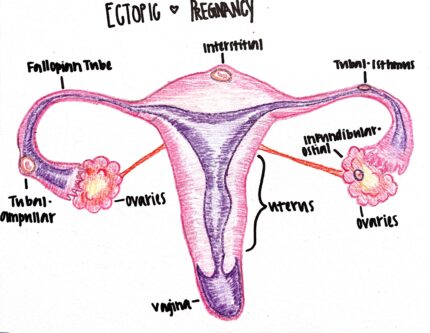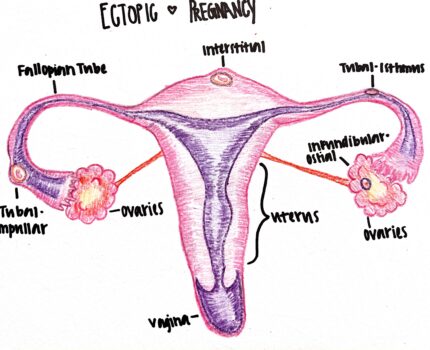Ectopic Pregnancies
A healthy pregnancy occurs within the uterus. As the sperm travels through the cervix to the fallopian tubes, the hope is that it will come into contact with an egg that is moving through the fallopian tubes at the same time. Once contact is made, they are able to join together to begin fertilization. Once fertilization is complete and a blastocyst is formed, pregnancy is determined by the blastocyst attaching to the uterine wall. Throughout the gestational period, the embryo will continue to grow and develop within the uterus until it is time for the baby to be birthed. However, there are instances where pregnancies can occur outside the uterus resulting in a life-threatening condition known as ectopic pregnancy.
Ectopic means “out of place” (Marshall). The British Columbia Medical Journal, in the article “Diagnosis and Treatment of Ectopic Pregnancies,” by Sanya Ranchal, BSc and Caitlin Dunne, MD, FRCSC, defines ectopic pregnancies as “implantation of an embryo outside the endometrium” and states that “ectopic pregnancy occurs when a developing embryo implants at a site other than the endometrium of the uterine cavity, most commonly within the fallopian tube.” Even though the majority of ectopic pregnancies occur within the fallopian tubes, there are other areas in which ectopic implantation can occur. According to Tyler Mummert and David Gnugnoli, ectopic pregnancies can take place within the cervix, uterine cornea, myometrium, ovaries, and abdominal cavity (Mummert).
Ectopic pregnancies are known to be rare, but there are risk factors that can contribute to their occurrence. Women who have a history of ectopic pregnancies are the most well-documented to have risk of further ectopic pregnancies (Ranchal). Tubual ligation and pelvic inflammatory disease increase the threat (Ranchal). Tobacco use, history of mental health conditions such as anxiety or depression, the use of intrauterine device (IUD), or undergoing in vitro fertilization also increase the risk for women to have ectopic pregnancies (Ranchal).
For an ectopic pregnancy to occur, there are things that need to happen that vary from a typical uterine healthy pregnancy. Following ovulation, when the egg is to be fertilized, fertilization has to occur outside of the endometrium of the uterus (Marshall). As the egg moves, it has to settle in an area that is rich in blood to assist with embryo development (Marshall). Like in a normal pregnancy, the embryo begins to grow and develop. However, depending on where the embryo has implanted, insufficient blood supply from the neighboring tissue can lead to death (Marshall). In uterine pregnancies, embryos receive nutrients, blood, and hormones form the placenta and the corpus luteum. The placenta causes an influx of hormones like estrogen progesterone, which results in stopping the shedding of the uterine wall, which in turn causes missed periods, enlargement of breasts, darkening of areolas, and weight gain. In ectopic pregnancies, embryos are still able to receive blood, nutrients, and hormones and mothers still go through hormonal anatomical and physiological changes (Marshall).
As most fetuses begin to grow and develop, mothers prepare for birth. In ectopic pregnancies, circumstances change. The embryos do not make it to term and mothers’ lives are put at risk. Tanner Marshall, MS, states,
If the ectopic pregnancy occurs in the ampulla of the fallopian tube, it eventually runs out of space. Slowly the ectopic pregnancy stretches the nerve fibers within the wall of the fallopian tube, causing lower abdominal pain. Eventually, the expansion causes damage to the wall of the ampulla, potentially rupturing the fallopian tube. A ruptured ectopic can also lead to massive hemorrhaging into the abdominal cavity, and the blood can irritate the peritoneum which can cause referred pain to the shoulder. Occasionally, there can be light vaginal bleeding as well. The combination of internal bleeding, severe pain, and damage to the fallopian tube make an ectopic pregnancy a medical emergency.
In order to avoid a life-threatening emergency, it is essential to detect and treat. Knowing the symptoms and risk factors are key. If an ectopic pregnancy does occur, it can be treated surgically or with a medicated injection. Mummert states: “Administration of intramuscular methotrexate or performance of laparoscopic surgery is safe and effective treatment modalities in hemodynamically stable women with a non-ruptured ectopic pregnancy” (Mummert).
It is important for women to know and understand the risks for ectopic pregnancy. Not all ectopic pregnancies are life-threatening, but they can be, so early detection is essential. If women, understand the risk factors, limit behavior that increases risk, and get checkups when symptomatic, they can reduce the risks that ectopic pregnancies pose to their own lives.
References:
Marshall, T., Debevec-Mckenney, E., Davis, C., Chessen, K., & Desai, R. (n.d.). Ectopic pregnancy | osmosis. Osmosis Elsevier. Retrieved July 23, 2022, from https://www.osmosis.org/learn/Ectopic_pregnancy
Mummert T, Gnugnoli DM. Ectopic Pregnancy. [Updated 2021 Dec 9]. In: StatPearls [Internet].Treasure Island (FL): StatPearls Publishing; 2022 Jan-. Available from: https://www.ncbi.nlm.nih.gov/books/NBK539860/
Ranchal, S., & Dunne, C. (2021, April). Sanya Ranchal, BSC, Caitlin Dunne, MD, FRCSC. diagnosis and treatment of ectopic pregnancy. BCMJ, vol. 63, no. 3, April, 2021, Page(S) 112-116 – clinical articles. British Columbia Medical Journal . Retrieved July 22, 2022, from https://bcmj.org/articles/diagnosis-and-treatment-ectopic-pregnancy


